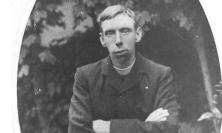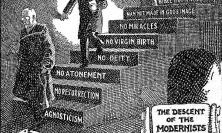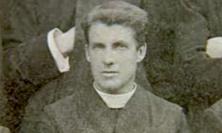George Tyrrell SJ was among the modernists whose ideas were condemned by the Catholic Church in the early twentieth century, but what was it about their thought that was so problematic? Continuing Thinking Faith’s series to mark the 100th anniversary of Tyrrell’s death, Anthony Carroll explores the philosophical background to modernism and asks if there is anything we can learn from the Church’s encounter with the movement – how might the modernists help us to think about our faith today?
At the start of the twentieth century, the Catholic Church found itself in a position of opposition to the dominant cultural trends in Europe. Increasingly defined by a functional rationality which had embodied itself in structures of work, in styles of art and architecture, and in philosophical currents, the modern world seemed to be departing from its religious roots and leaving only nostalgia for the sacred in their place. In the so-called ‘modernist crisis’, one can see this oppositional relationship between the Church and the world in particularly sharp focus.
Pascendi
In the September 1907 Encyclical of Pope Pius X, Pascendi Dominici Gregis (hereafter Pascendi), this confrontation with certain modern currents of philosophical and theological thought came to a head in an outright condemnation of tendencies that were felt to undermine the Church and her propagation and defence of the faith – tendencies that were grouped together and known as ‘modernism’. Chief amongst the characteristics condemned were those said to be of philosophical origin, namely agnosticism and immanentism, as we shall explore later. Yet the paradox of this Encyclical, and indeed of the modernism conflict in general, is that whilst a variety of thinkers clearly shared some of the ideas condemned, it was really only through this Encyclical that ‘modernism’ as a coherent and unified body of thought can be said to have existed.
Pascendi in many ways constructs modernism as a straw man in order to defend a certain style of philosophy and theology that had been designated as official for the Catholic Church by Pope Leo XIII in his 1879 Encyclical Aeterni Patris: that of Saint Thomas Aquinas. The dominance of this style had been reinforced by a resurgence of interest in Aquinas in the nineteenth century from the movement that became known as Neo-Thomism. Important centres for the propagation of Thomistic ideas developed in Europe and their influence was felt on the various letters and decrees issued by the Church against modernist trends in philosophy and theology at the end of the nineteenth and beginning of the twentieth century.
However, the roots of what is termed ‘philosophical modernism’ lie well before the modernist crisis of the twentieth century. In fact, one has to trace them back to the break-up of the medieval synthesis in theology and philosophy that was ushered in by Nominalism in the eleventh century. Nominalism was a philosophical movement that held that it was not possible to know universals or general realities, but that all one could safely come to know and to talk sensibly about were particulars. The tendency towards this thought led to a disbelief in a realist approach to the world and so too the view that one could come to know God in and through sensible reality. This breakdown of the medieval synthesis of thought was further intensified by scientific advances which gradually discredited the Aristotelian conception of the universe. In these early modern times, science was becoming increasingly able to predict and have some control over nature in ways which previously had been thought impossible. As philosophical trends began to distance themselves from traditional medieval thought, a new secular philosophy emerged which began to conceive of the world as if God were not necessary for its comprehension. This philosophy would increasingly separate faith from reason and develop a rationality that would be guided by rules which were autonomous from religious concerns. Thinkers such as Descartes, Locke, and Hume all began to pose questions and to provide answers that were no longer tied to those of traditional medieval philosophy.
Kant
Chief among the opponents of the medieval system of thought who would cause concern for the Church at the time of the modernist crisis was the German philosopher Immanuel Kant. Kant asserted that medieval and early modern thought had failed to question the appropriate limits of human reason and so had become tangled up in interminable confusions. His critical philosophy would famously deny the capacity of reason to come to know God, in order to make room for faith. For Kant, God could not be affirmed through our sensory perceptions but could be a postulate of practical reason that would ground our moral action.
The Neo-Thomism of the nineteenth century would react against the Kantian denial of the possibility of knowledge of God by developing ever more sophisticated ways of proving that God could be known in our ordinary acts of cognition. However, other thinkers such as Maurice Blondel, Lucien Laberthonnière, and Edouard Le Roy thought that one could simply not pretend that the Kantian revolution had not transformed the way human knowledge was conceived of. Rather than trying to show that Kant was wrong, these thinkers sought in their different ways to come to terms with Kant’s philosophy without being subservient to it. Their ideas provided the philosophical background to the more theologically orientated modernists – such as the Anglo-Irish Jesuit George Tyrrell – and, as Pascendi characterised the modernists by the principles of agnosticism and immanentism, it would be their thought that was criticised in the Encyclical.
Immanentism
Conscious of the challenge to the traditional Thomist theory of knowledge that had been ushered in by modern philosophy, Blondel, for example, sought to identify the practical level of human action as the place where one might find a new apologetic for the Christian faith. In his L’Action (1893), he analyses the dynamics of human action and argues that the distance between what we desire and what we actually realise in our actions indicates that what we truly desire lies always beyond the particular object that we are momentarily fixed upon. This transcendental horizon of desire draws the mind and heart towards God as the only One who can satisfy truly our infinite longings. For Blondel, it is this Augustinian unrest that leaves a trace of the divine in our human experience. Such a turn to the interiority of human experience as grounds for the proof of God’s existence is what is meant by immanentism in Pascendi.
Rather than pointing towards the historical existence of Jesus, the factual occurrence of miracles and the fulfilment of earlier prophecies for proof of God’s existence, the Blondelian schema holds that justification for the faith is to be found by turning inwards to the personal experience of the human subject. This turn to the subject is characteristic of modern philosophy, from Descartes right up to the Idealism of Kant and Hegel and beyond, and presented a major challenge to the traditional Catholic apologetics of the time, which had been constructed on the basis that external revelation could be taken for granted. With this turn to the interior experience of the human subject, more than simply philosophical questions were raised. If it were the case that inner experience justified the faith, if each person was to find the proof of God’s existence within their own life, then what would be the basis for the teaching authority of the Church? Blondel was aware of this challenge to traditional apologetics but felt that only by taking seriously the Idealist challenge could Catholic apologetics be made effective for the modern age.
However, many Neo-Thomists felt that this subjective turn was just another form of Protestantism that would effectively remove from the Church any authority to teach on matters of faith and morals. The Dominican Marie-Benôit Schwalm, for example, accused Blondel of propagating heretical doctrines similar to Protestantism. He argued that Blondel had been seduced by Kantian philosophy and had forgotten the teachings of the Church in his desire to accommodate it to the modern world. At root, these Neo-Thomist critiques depended upon the view that one had to choose between Aristotle as interpreted by Aquinas and Aristotle as interpreted by Kant, and that orthodoxy lay with the former and heresy with the latter. There was no middle way between the two and all attempts to try and find one would lead to condemnation. Kant was seen as the philosopher of Protestantism and so those who sought to use his thought were suspected of having left the fold.
Agnosticism
The critique that the modernists were merely agnostics in disguise arose out of the fact that their doctrines were seen to have put into question the teachings of the Church on natural theology, that had been defined by the First Vatican Council in 1870. The Dogmatic Constitution Dei Filius of 24 April 1870 had argued, drawing on Rom 1:20, that it was possible to come to know God, using the light of natural reason, from the created order. This theory of theological knowledge was contradicted by the Kantian idea that reason was limited to the sensible realm and could not reach beyond this to a transcendental God who lay beyond space and time. Pascendi argued that such Kantian epistemological agnosticism joins easily with the presupposition of methodological atheism, which held that science and history have to be viewed without God if they are to be truly scientific. In the Thomist and Neo-Thomist perspectives, history and science can never be said to be devoid of the divine presence, and so in order to properly understand them one has to acknowledge their ultimate orientation to God and the good.
The term ‘agnosticism’ had been created by Thomas Huxley in his 1869 Collected Essays, and it is not an exaggeration to say that agnosticism became the new faith of the nineteenth century as the use of the critical method in the historical sciences became popular. It is important, therefore, to recognise that whilst the modernist crisis within the Church had academic foundations, it also has to be seen within a social and cultural context of increasing doubt about religion and its ability to deliver reliable knowledge about God and the world. The intellectual and social currents came together at the start of the twentieth century to condemn attempts by the modernists who sought to build bridges between the Church and the world outside of the Church.
An unfinished project
Interesting as this foray into Church history may be, one should ask the question: what, if anything, has the experience of the modernist crisis to teach us in our attempts to think the faith today?
Undoubtedly, our context is different from that of the early twentieth century Church. The Copernican shift that the Second Vatican Council inaugurated within the Church is one which, in many ways, has vindicated the impulses of the modernists in their attempts to come to terms with the challenges of the modern world. Yet, whilst our contexts may differ it seems as if some of the challenges remain surprisingly similar. The challenge of developing ways of propagating and defending the faith that are more than simply condemnatory of the modern world is clearly a task that we share in common with our modernist forebears. In attempting to come to terms with the Kantian revolution in philosophy, the modernists still provide a positive impulse for our times. By entering into dialogue with Kantian philosophy, they clearly ran the risk of allowing it to so structure their thought that in the end they would only mimic the secular world that they were attempting to evangelise. This is always the risk: that in entering into the cultural trends and thought patterns of an age, one becomes colonised by them. Yet, and certainly in the case of philosophers such as Maurice Blondel and even more so with later thinkers such as the Jesuits Karl Rahner and Bernard Lonergan, it is clear that if one is to innovate one has to risk entering into often alien territories of thought in order to find new ways of expressing old truths. In doing so, the modernists remind us that the challenge of thinking the faith is one that each generation has to make its own and always remains an unfinished project.
Anthony J. Carroll teaches philosophy at Heythrop College, University of London.
Thinking Faith’s series on George Tyrrell SJ:
![]() George Tyrrell and Catholic Modernism – Oliver Rafferty SJ
George Tyrrell and Catholic Modernism – Oliver Rafferty SJ![]() George Tyrrell and John Sullivan: Sinner and Saint? – Michael Hurley SJ
George Tyrrell and John Sullivan: Sinner and Saint? – Michael Hurley SJ![]() Faith, Reason and the Modernists – Joe Egerton
Faith, Reason and the Modernists – Joe Egerton






